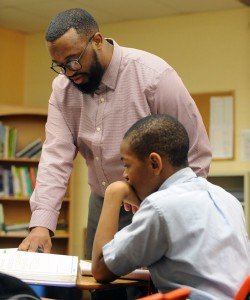By JAN WILLMS
Staff, parents and students at St. Peter Claver Catholic School, 1060 W. Central Ave., will no longer have to worry each year whether the school will continue to stay open.
The school has become a part of the newly formed Ascension Catholic Academy, described as a paradigm for urban Catholic schools in the Twin Cities. The other schools involved are Ascension Catholic School in north Minneapolis and St. John Paul II Catholic Prep School in northeast Minneapolis.
The Academy concept originated with, and was initially funded by, the GHR Foundation, started in 1965 by Gerald and Henrietta Rauenhorst. The Foundation seeks transformational change in education, health, and global development.
 Photo right: DeMod McGruder, an 8th grader at St. Peter Claver Catholic School, at computer. (Photo submitted)
Photo right: DeMod McGruder, an 8th grader at St. Peter Claver Catholic School, at computer. (Photo submitted)
“The traditional parish school is led by a pastor, who then hires the principal and oversees the school,” said Meg Nodzon, senior program officer for the GHR Foundation. “In this model, the pastors of the three schools have ceded their authority to a board of directors that is made up of both clergy and lay people who will then manage all three schools together, which is a new form of governance for this archdiocese.”
Nodzon expressed gratitude to Archbishop Bernard Hebda and Bishop Andrew Cozzens, who partnered with GHR and the schools to adopt this new model.
“There was always the question of whether St. Peter Claver could stay open, and similar concerns with St. John Paul II,” Nodzon explained. “We wanted to look at whether there was a model that not only could stabilize the schools fiscally but could at the same time boost the academics so we could continue to close the achievement gap.”
Nodzon said that Ascension Catholic School was doing well both academically and financially. “They had a good basis of support, and a lot of partnerships throughout the community,” Nodzon claimed. “The model was based on Ascension being the anchor and helping to disseminate best practices and stability for all three schools.”
 Photo left: Augustus Young, MS Math/Science teacher at St. Peter Claver, assists a student. (Photo submitted)
Photo left: Augustus Young, MS Math/Science teacher at St. Peter Claver, assists a student. (Photo submitted)
Patty Stromen, president of Ascension Catholic Academy, said the GHR Foundation had looked at many sites and at what was the cutting edge of how urban Catholic schools were succeeding. She said GHR looked at best practices and discussed what could happen locally.
“That translated to a more focused conversation around a wealth of information about what was working and what wasn’t working,” Stromen said. “Each situation is unique, so we didn’t simply take one model and institute it here, but considered the nuances of this archdiocese and the two cities. We’re bridging St. Paul and Minneapolis, and in Minneapolis, bridging north and northeast.”
Conversations have been in place for two years, and the project was put into effect Aug. 1.
Therese Shimshock, principal at St. Peter Claver, has been on board since August. She was previously an administrator at Faithful Shepherd in Eagan for 11 years.
“I took some time off and was trying to figure out what I want to do when I grow up,” she recalled. “I was at daily Mass, asking God whether I should go to a public school or do consulting. Mass was at 8:30am, and at 8:32 Patty had left me a phone call. I think God was saying He had tried to give me these little subtle hints but I hadn’t gotten them, so he was going to hit me over the head with a 2x4.”
 Photo right: Elonzo Simmons, Kaleb Carter, and Elijah Simmons, are all 5th grade students at St. Peter Claver. (Photo submitted)
Photo right: Elonzo Simmons, Kaleb Carter, and Elijah Simmons, are all 5th grade students at St. Peter Claver. (Photo submitted)
“Patty asked me if I would be interested in coming in and talking. I told her that I am just a suburban white woman with no urban experience. We talked through that piece of it, and here I am,” Shimshock said.
The school originally opened in the 1950s and was closed in the 1980s. After about 20 years, it reopened in 2000. The school has always had an African focus, reflected in the African design on the floors of the hallway. The student population of K-8 is currently 68.
Shimshock said St. Peter Claver is in a reboot stage right now. Out of 10 teachers, eight are new. “Being under the Academy has allowed us to create a culture that is different from our past, not that we are forgetting our African roots. But it has let us start over and give these kids the academics and skills that they need to move forward.”
“One of the things Patty did was hire a dean of students,” Shimshock explained. “Even though we have a very low population in numbers, the kids that come to us have emotional or academic concerns. Andre Knight, our dean of students, is an African American man who brings that piece to it. While I work on the academic needs, he works on the behavioral part, which is phenomenal.”
All the schools in the Academy, according to Stromen, have over 70 percent of students in the free or reduced lunch program. Over 90 percent of students are children of color.
“Most of the scholars in all three of our schools come to us at an average of two years behind grade level,” she continued. “So it’s not only helping them achieve, but closing that achievement gap and progressing them through at a faster rate than students at grade level.”
She emphasized that all three schools have individualized learning plans, with a very specific awareness of each scholar’s needs, particularly in reading and math.
Stromen said that although it is in early stages, so far the program seems to be going well. “We’re looking at how we build structures, how we increase academic success and financial sustainability and how we bring best practices to each and every area of the organization.”
 Photo right: Elicia Stevens was a 7th grade student at St. Peter Claver. (Photo submitted)
Photo right: Elicia Stevens was a 7th grade student at St. Peter Claver. (Photo submitted)
“We have a half-time enrollment manager, and half of her time is here in St. Paul, knowing we want to increase enrollment here next year.” She said that regarding structure, the Academy had built a comprehensive IT program. “Instead of each school trying to manage on its own, or manage emergencies, we now have a very cohesive way to do that. Whether it’s a piece of equipment that needs to be purchased or something that needs to be fixed, everyone knows who to go to. That doesn’t sound like a lot, but in a school setting it can make a big difference.”
Stromen stated that finance, HR, bookkeeping, volunteer and enrollment management, traditional development and raising of funds are all centralized.
“We brought Ascension’s best practices for finance, HR, and volunteer management to the other schools as well,” she said. “Ascension is also strengthened in the process.”
Stromen added that all three schools not only want their scholars to graduate from high school, but to also be post-secondary education ready.
Nodzon said St. Peter Claver is one of the last Catholic schools in an urban setting in St. Paul. “With the Ascension Catholic Academy, we can ensure scholars will have a school in their neighborhood for hopefully many, many years to come.”
“A school that educates children successfully, and in this case in a faith setting, brings hope to a neighborhood,” added Stromen. “We see our mission as educating any child who comes to us along with a family member who desires to be educated in a faith setting, regardless of what their faith background is.”
“Some people say why are Catholics educating non-Catholics? We say it’s because we are Catholic. It’s part of our mission to educate children who deserve strong, positive, successful education, and we welcome anyone who walks in the door.”
She said the schools are in neighborhoods where there are families of color, many living in poverty, many not Catholic. “Let’s open the doors,” she said.
Stromen said she has the delight of signing off every Thursday morning on deposits. “Today there was a $5 gift from someone and a $50,000 gift from someone,” she related. “We honor each of these gifts, no matter the size.”
“As a Twin Cities community, and as individual neighborhoods, it’s all of us together giving all of our unique gifts that are going to provide a future full of hope for these amazing scholars that we know and the scholars that are going to come to us that we don’t yet know,” Stromen continued. “Each and every child who lives in this neighborhood deserves that future of hope and deserves an education, and their needs met, and deserves to be in a safe setting.”
Comments
No comments on this item Please log in to comment by clicking here